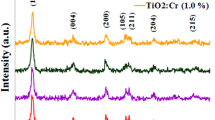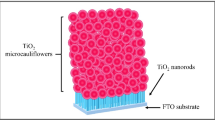Abstract
According to reports, a unique method to improve the efficiency of titanium dioxide (TiO2) dye-sensitized solar cells (DSSCs) involves inserting foreign ions into the material’s lattice structure before forming the heterostructure. The sol–gel technique has been used to produce films of TiO2, Cr–TiO2, TiO2@Cr–TiO2, and Cr–TiO2@TiO2. A small quantity of rutile phase with the anatase phase was observed in heterostructures, and XRD validated the anatase phase of pure Cr–TiO2@TiO2, which contains a large grain size (46 nm). SEM presents numerous well-formed, homogenous grains in the structure of Cr–TiO2@TiO2, providing a large surface area for dye loading in DSSCs. Among all samples, Cr–TiO2@TiO2 exhibits a small band gap (Eg) (3.2 eV), and high transmittance in the visible spectrum has been observed by UV–Vis spectroscopy. The Cr–TiO2@TiO2 cell demonstrates high Jsc (7.69 mA-cm−2), Voc (0.79 V), and efficiency (4.57%). The small recombination resistance, verified from EIS, is responsible for this high efficiency.











Similar content being viewed by others
Data availability
Data will be made available on request.
References
M. Asemi, A. Suddar, M. Ghanaatshoar, Increasing the specific surface area of Cr-doped TiO2 nanoparticles by controlling the drying time for DSSC applications. J. Mater. Sci. Mater. Electron.. Electron. 28, 15233–15238 (2017)
M. Abushad et al., Physical properties and photocatalytic activity of Cr-doped TiO2 nanoparticles. J. Microsc.Microsc. 291(3), 210–228 (2023)
M. Khan et al., Improving the current density and reducing the recombination rate of dye sensitized solar cells by modifying the band gap of Titania using Novel heterostructures. Opt. Mater. 140, 113780 (2023)
M. Momeni, Dye-sensitized solar cells based on Cr-doped TiO2 nanotube photoanodes. Rare Met. 36(11), 865–871 (2017)
M. Mohammadi et al., Improved efficiency of dye-sensitized solar cells by design of a proper double layer photoanode electrodes composed of Cr-doped TiO2 transparent and light scattering layers. J. Sol-Gel Sci. Technol. 67, 77–87 (2013)
S. Karthick et al., Dye‐sensitized solar cells: history, components, configuration, and working principle. Interfacial Engineering in Functional Materials for Dye‐Sensitized Solar Cells, 2019: p. 1–16.
J.A. Anta, E. Guillén, R. Tena-Zaera, ZnO-based dye-sensitized solar cells. The Journal of Physical Chemistry C 116(21), 11413–11425 (2012)
P. Tiwana et al., Electron mobility and injection dynamics in mesoporous ZnO, SnO2, and TiO2 films used in dye-sensitized solar cells. ACS Nano 5(6), 5158–5166 (2011)
J. Bandara, H. Weerasinghe, Solid-state dye-sensitized solar cell with p-type NiO as a hole collector. Sol. Energy Mater. Sol. Cells 85(3), 385–390 (2005)
D. Xiong et al., Enhanced performance of p-type dye-sensitized solar cells based on ultrasmall Mg-doped CuCrO2 nanocrystals. Chemsuschem 6(8), 1432–1437 (2013)
D. Yao et al., Photocatalytic degradation of malachite green by titanium dioxide/covalent organic framework composite: characterization, performance and mechanism. ChemistryOpen (2024). https://doi.org/10.1002/open.202300209
D. Hyun Kim et al., Photocatalytic activity of Ni 8 wt%-Doped TiO2 photocatalyst synthesized by mechanical alloying under visible light. J. Am. Ceram. Soc. 89(2), 515–518 (2006)
R. Senthamarai et al., Synthesis and characterization of nickel doped TiO2 nanoparticles by green method and its performance as dye-sensitized solar cells photoanodes. Int. J. Energy Res. 46(6), 7749–7757 (2022)
M. Fazil et al., Enhanced photo/electrocatalytic hydrogen evolution by hydrothermally derived Cu-doped TiO2 solid solution nanostructures. Langmuir (2024). https://doi.org/10.1021/acs.langmuir.3c02860
Q. Deng et al., Mn-doped TiO2 nanopowders with remarkable visible light photocatalytic activity. Mater. Lett. 65(13), 2051–2054 (2011)
Y. Matsumoto et al., Room-temperature ferromagnetism in transparent transition metal-doped titanium dioxide. Science 291(5505), 854–856 (2001)
R. Dubey, S. Singh, Investigation of structural and optical properties of pure and chromium doped TiO2 nanoparticles prepared by solvothermal method. Results Phys. 7, 1283–1288 (2017)
N. Rajamanickam, K. Ramachandran, Empowering dye-sensitized solar cells with Cr-doped SrTiO3 nano system: a promising approach to tackle carrier leakage and boost efficiency. Opt. Mater. 138, 113730 (2023)
H.H. Nguyen et al., Cr-doped TiO2 nanotubes with a double-layer model: an effective way to improve the efficiency of dye-sensitized solar cells. Appl. Surf. Sci. 458, 523–528 (2018)
M. Roudgar-Amoli, Z. Shariatinia, Dye-sensitized solar cells with efficiencies exceeding 10% engineered based on La2MnTiO6 double perovskite and MOF-derived Cr2O3/C nanocomposites in bi-layered photoanodes. Opt. Mater. 145, 114456 (2023)
A. Najafi et al., Influence of pH and temperature parameters on the sol-gel synthesis process of meso porous ZrC nanopowder. Ceram. Int. 48(18), 26725–26731 (2022)
G. Khalaj et al., Evaluation of APC impact on controlling precursors properties in the sol for synthesizing meso porous ZrC nanopowder through sol-gel process. J. Market. Res. 26, 6182–6192 (2023)
M. Rahmani-Azad et al., Improvement of ZrB2 nanopowder synthesis by sol-gel method via zirconium alkoxide/boric acid precursors. J. Sol-Gel Sci. Technol. 103(1), 87–96 (2022)
O. Fakhimi, A. Najafi, G. Khalaj, A facile rout to obtain Al2O3 nanopowder via recycling aluminum cans by sol-gel method. Mater. Res. Express 7(4), 045008 (2020)
F. Sharifi et al., Synthesis and characterization of mesoporous TiC nanopowder/nanowhisker with low residual carbon processed by sol–gel method. J. Market. Res. 22, 2462–2472 (2023)
F. Fresno et al., Influence of the structural characteristics of Ti1− xSnxO2 nanoparticles on their photocatalytic activity for the elimination of methylcyclohexane vapors. J. Appl. Catal. B: Environ. 55(3), 159–167 (2005)
K.-N.P. Kumar et al., Synthesis and textural properties of unsupported and supported rutile (TiO2) membranes. J. Mater. Chem. 3(9), 923–929 (1993)
M.I. Yasin et al., Facile synthesis of TiO2 and Sn-TiO2 heterostructures based photoanodes for dye sensitized solar cells. Int. J. Energy Res. 45(13), 18875–18884 (2021)
S. Ng et al., Grain size effect on the electrical and magneto-transport properties of nanosized Pr0.67Sr0.33MnO3. Results Phys. 9, 1192–1200 (2018)
T. Berger et al., An electrochemical study on the nature of trap states in nanocrystalline rutile thin films. J. Phys. Chem. C 111(27), 9936–9942 (2007)
S. Wang et al., High-performance perovskite solar cells with large grain-size obtained by using the Lewis acid-base adduct of thiourea. Solar Rrl 2(6), 1800034 (2018)
A.K. Tripathi et al., Structural, optical and photoconductivity of Sn and Mn doped TiO2 nanoparticles. J. Alloys Compd. 622, 37–47 (2015)
Y. Duan et al., Influence of Sn source on the performance of dye-sensitized solar cells based on Sn-doped TiO2 photoanodes: a strategy for choosing an appropriate doping source. Electrochim. Acta. Acta 107, 473–480 (2013)
M.A. Gil et al., Ag/Cr–TiO2 and Pd/Cr–TiO2 for organic dyes elimination and treatment of polluted river water in presence of visible light. Nanomaterials 13(16), 2341 (2023)
F. Vargas et al., Photochemical and Sonochemical Strategies in Advanced Oxidation Processes for Micropollutants’ Treatments, in Advanced Oxidation Processes for Micropollutant Remediation. (CRC Press, 2024), pp.65–98
J.B. Mann et al., Configuration energies of the d-block elements. J. Am. Chem. Soc. 122(21), 5132–5137 (2000)
L. Wu et al., Core-shell composite MIL-101 (Cr)@ TiO2 for organic dye pollutants and vehicle exhaust. Molecules 28(14), 5530 (2023)
B. Hao et al., Cr-doped TiO2/CuO photocatalytic nanofilms prepared by magnetron sputtering for wastewater treatment. Ceram. Int. 48(5), 7106–7116 (2022)
D. Mardare et al., On the structural properties and optical transmittance of TiO2 rf sputtered thin films. Appl. Surf. Sci. 156(1–4), 200–206 (2000)
S. Kanwal et al., A facile green approach to the synthesis of Bi2WO6@ V2O5 heterostructure and their photocatalytic activity evaluation under visible light irradiation for RhB dye removal. Arab. J. Chem. 16(5), 104685 (2023)
V. Luca, S. Djajanti, R.F. Howe, Structural and electronic properties of sol−gel titanium oxides studied by X-ray absorption spectroscopy. J. Phys. Chem. B 102(52), 10650–10657 (1998)
J. Podder, How to calculate real and imaginary parts of dielectric constant from impedance measurement? 2018 [cited 2020 20 September]; Available from: https://www.researchgate.net/post/How_to_calculate_real_and_imaginary_parts_of_dielectric_constant_from_impedance_measurement/5bd2b0b5a7cbaf40791e64e5/citation/download. Accessed 20 Sept 2020
G. Xie et al., Effect of In-doping on the optical constants of ZnO thin films. Phys. Procedia 32, 651–657 (2012)
A. Ahad et al., Effect of chromium doping on the band gap tuning of titanium dioxide thin films for solar cell applications. Heliyon 10(1), e23096 (2024)
B.P. Dhonge et al., Spray pyrolytic deposition of transparent aluminum oxide (Al2O3) films. Appl. Surf. Sci. 258(3), 1091–1096 (2011)
S. Dhanapandian, A. Arunachalam, C. Manoharan, Highly oriented and physical properties of sprayed anatase Sn-doped TiO2 thin films with an enhanced antibacterial activity. J Appl. Nanosci. 6(3), 387–397 (2016)
N. Zarrin et al., Thermally stimulated small polaron promoted conduction mechanism in Fe-doped La0.7Sm0.3CrO3. J. Phys. Chem. Solids 138, 109281 (2020)
R. Gao et al., Influence of core size on the multiferroic properties of CoFe2O4@ BaTiO3 core shell structured composites. Ceram. Int. 44, S84–S87 (2018)
R. Gao et al., Enhancement of magnetoelectric properties of (1–x)Mn0.5Zn0.5Fe2O4-xBa0.85Sr0.15Ti0.9Hf0.1O3 composite ceramics. J. Alloys Compd. 795, 501–512 (2019)
Y. Zhang et al., Synthesis of Zn-doped TiO2 microspheres with enhanced photovoltaic performance and application for dye-sensitized solar cells. Electrochim. Acta. Acta 56(18), 6517–6523 (2011)
J.-H. Lee et al., Thickness effect of the TiO2 nanofiber scattering layer on the performance of the TiO2 nanoparticle/TiO2 nanofiber-structured dye-sensitized solar cells. Curr. Appl. Phys.. Appl. Phys. 14(6), 856–861 (2014)
M. Asemi, M. Ghanaatshoar, The influence of magnesium oxide interfacial layer on photovoltaic properties of dye-sensitized solar cells. Appl. Phys. A 122, 1–7 (2016)
M. Asemi, S. Maleki, M. Ghanaatshoar, Cr-doped TiO2-based dye-sensitized solar cells with Cr-doped TiO2 blocking layer. J. Sol-Gel Sci. Technol. 81, 645–651 (2017)
Acknowledgements
The authors express their gratitude to Princess Nourah bint Abdulrahman University Researchers Supporting Project number (PNURSP2024R11), Princess Nourah bint Abdulrahman University, Riyadh, Saudi Arabia. The authors extend their appreciation to the Deanship of Scientific Research at King Khalid University (KKU) for funding this research through the Research Group Program Under the Grant Number: (R.G.P.1/431/44).
Funding
This research was funded by Princess Nourah bint Abdulrahman University Researchers Supporting Project number (PNURSP2024R11), Princess Nourah bint Abdulrahman University, Riyadh, Saudi Arabia.
Author information
Authors and Affiliations
Corresponding authors
Ethics declarations
Conflict of interest
Authors have no conflict of interests.
Additional information
Publisher's Note
Springer Nature remains neutral with regard to jurisdictional claims in published maps and institutional affiliations.
Rights and permissions
Springer Nature or its licensor (e.g. a society or other partner) holds exclusive rights to this article under a publishing agreement with the author(s) or other rightsholder(s); author self-archiving of the accepted manuscript version of this article is solely governed by the terms of such publishing agreement and applicable law.
About this article
Cite this article
Yasin, M.I., Khan, M.I., Kanwal, S. et al. A novel heterostructure of Cr-doped TiO2 for reducing the recombination rate of dye sensitized solar cells. J. Korean Ceram. Soc. (2024). https://doi.org/10.1007/s43207-024-00391-z
Received:
Revised:
Accepted:
Published:
DOI: https://doi.org/10.1007/s43207-024-00391-z




